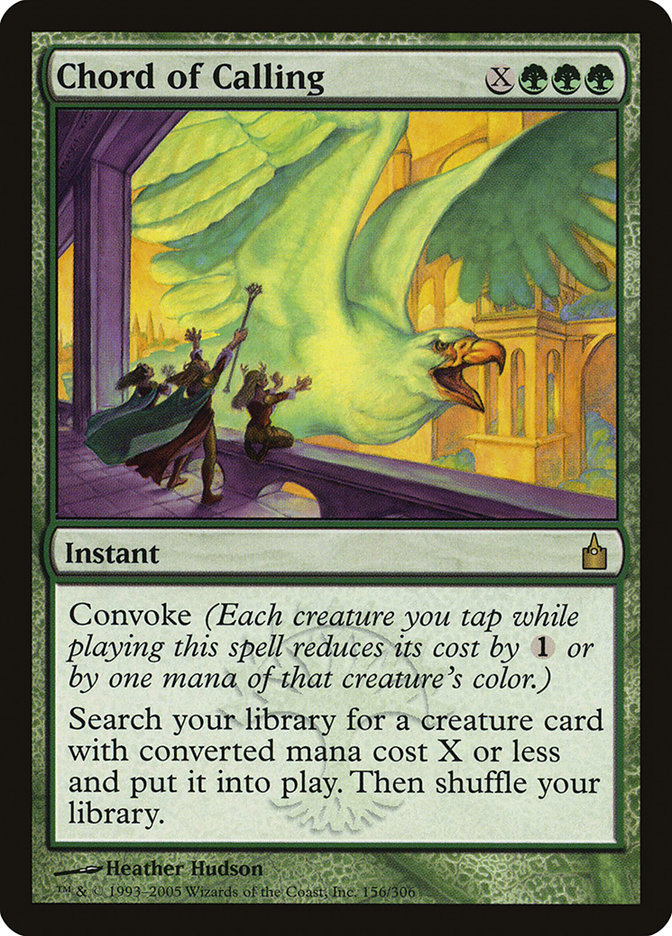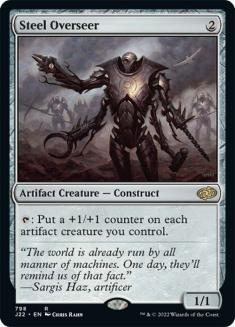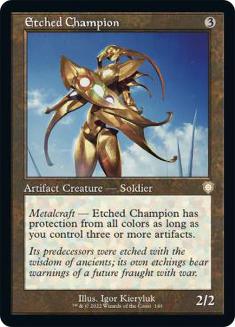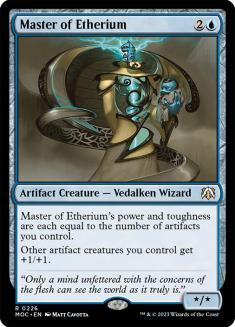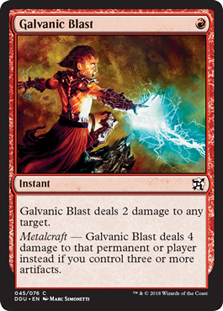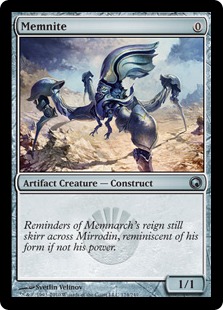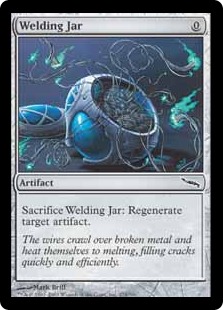One of the plans I had for this previous weekend was to go to a double-PTQ extravaganza, hitting up both a PTQ in Canton, OH (near-ish to Cleveland) and if
I didn’t win, following it up with either a PTQ in Fort Wayne, IN or Chicago, depending on when I finished in Ohio, mostly.
Of course, 10 minutes into the eight hour drive, I decided to get into a
fairly bad car accident and wreck my car. Luckily, no one was hurt. I was shaken, surprisingly scared even after the accident, and really just in
a daze. It wasn’t until I got a text from my fellow Madisonian Matt Severa asking if I was looking for a ride to another upcoming PTQ that it
dawned on me that I’d missed two events that weekend.
Thanks to the good folks at Universal Comics, who played host to the
event, the top decks are available. Let’s check them out!
2 Affinity *winner*
1 Jund
1 G/R Tron
1 Kiki-Pod
1 U/R Delver
I don’t know about you, but that kind of diversity in the Top 8 smacks to me of Legacy. While this is only a single PTQ, and first PTQs
of a season tend to have a ton of extra wildness going on, this PTQ result smacks of options. Last week, I went over the results of 320 top-performing Modern
decks, and I gave a few lessons that could be had from just looking solely at the very best-performing lists. Even collapsing several archetypes
into each other, there were still thirty-one different archetypes that had seen success.
If you look at the data from that article, there is a lot
to learn. Importantly, though, the most popular archetype among winners, Splinter Twin, only comprised 15% of the metagame. The winner, above, in
Canton, OH, was Affinity, with two decks in the Top 8, but in the previously recorded metagame of winners, only 5% of the top of the field was
Affinity. Fully 24% of the field, in fact, weren’t even playing a deck that was in the Top 10 most popular decks.
Modern is just diverse.
This week has been a complete fog as I’ve been dealing with the aftermath of the car accident, so while I had planned to try to do a breakdown of every PTQ
result from the weekend that I could gather, there was just so much on my plate otherwise, I thought that I’d look at this individual Top 8, and just
discuss the most interesting elements of each deck.
Creatures (15)
Lands (19)
Spells (26)
- 4 Lightning Bolt
- 4 Mana Leak
- 4 Serum Visions
- 4 Spell Snare
- 2 Burst Lightning
- 1 Spell Pierce
- 4 Gitaxian Probe
- 3 Vapor Snag
Sideboard

First of all, if you think the name “Chris Kronenberger” sounds familiar, it may be because of this deck:
Creatures (4)
Planeswalkers (3)
Lands (6)
Spells (47)

I remember commentating on Chris’s win in Louisville with Gavin Verhey, and it was truly an impressive display by Chris. “Kronenberger Blue” would be a
rare sight in the time after that event, but it still would occasionally pop up. Chris would take out AJ Sacher in his path to winning Louisville, and it
was an impressive Top 8, with Todd Anderson, Joe Bernal, and Caleb Durward joining them.
As far as Chris’s Modern choice, this is a fairly straightforward build of U/R Delver. Chris is only running three of the “Blue Path to Exile”, Vapor Snag,
a choice I’ve usually seen go the other way, but other than that, his main deck is all about efficiency, with a monster of a curve:
0: 4
1: 24
2: 12
3: 1
Unlike a lot of these lists, he’s not running Remand, but I know from my experience, it has been very hard to justify Remand in this metagame; everything
just feels like it is so cheap. Remand has been deeply underperforming for me in lists that are trying to end the game or might actually be controlling the
game.
The sideboard has a strong nod to artifacts with 2 Steel Sabotage and 2 Hurkyl’s Recall. While Chris obviously didn’t end up winning, I think recognizing
that de facto aggressive enemy #1 is Affinity is important, and Chris made that call correctly.
Creatures (13)
Lands (23)
Spells (24)
- 4 Sleight of Hand
- 4 Serum Visions
- 1 Echoing Truth
- 2 Remand
- 3 Dispel
- 4 Flame Slash
- 4 Splinter Twin
- 2 Izzet Charm
Sideboard

The first interesting thing about Zachery Hill is the four Flame Slash in the main deck. That is a metric ton of Flame Slashes! One of the things
that has seemed to become common knowledge in Modern is that everyone has a deck that can put forth some kind of resistance to a combo. Flame
Slash can exist to protect the combo (kill their Spellskite), but importantly, it can also be used as active disruption.
Four Flame Slash is a claim that this deck is not going to try to dedicate itself to a race, but rather, is going to make a nod that the game can be slowed
down. Whether it is taking a moment to kill an aggressive creature or taking a moment to kill a utility creature, those slots are far more than insurance
against just ‘skite. This deck, in the main, will rarely win with less than infinite damage, so adding one damage onto a bolt effect is really effective in
making a “mono-red Almost Terminate”.
The sideboard is complete with countermeasures to people’s answers to the deck, but also the Control Plan B, where a Batterskull, Anger of the Gods, and
Blood Moon will all play together nicely should you decide to become the deck that just can win a grind while all the lands are mountains.
Creatures (31)
- 4 Birds of Paradise
- 2 Kiki-Jiki, Mirror Breaker
- 1 Wall of Roots
- 4 Kitchen Finks
- 1 Murderous Redcap
- 4 Noble Hierarch
- 1 Linvala, Keeper of Silence
- 3 Wall of Omens
- 1 Spellskite
- 2 Deceiver Exarch
- 1 Scavenging Ooze
- 1 Strangleroot Geist
- 4 Restoration Angel
- 1 Zealous Conscripts
- 1 Voice of Resurgence
Lands (23)
Spells (6)

At first, this list looked very stock to me. Then, I realized it was missing something:
Wow! In addition to running Path to Exile, this deck also eschews a full set of Wall of Roots (one of my favorite cards) in favor of several Wall of Omens.
This deck is definitely leaning slightly away from the “combo-off” Pod plan and is instead leaning towards the slightly more midrange “get value” plan.
With Kiki-Jiki, Mirror Breaker and Restoration Angel together, you can just win the game. But the inclusion of Wall of Omens means that separately, should
you not have the Birthing Pod to be totally abusive, you can just start to get that extra card here or there.
Paul is also running six City of Brass. Four Mana Confluence and two City of Brass is the kind of mana base that says, “I know the cost. I just
want to get these spells to work.” While personally I’d be worried about aggressive decks, (yes, even with four Kitchen Finks) you have to give Paul credit
for his courage on the mana.
The sideboard actually has a ton of interesting things it brings into the mix. Paul has an aggressive discard package. He has an excellent anti-artifact
package. He even has Eidolon of Rhetoric, useful in nixing Storm, among other things. Fiery Justice is probably the most exciting card in his sideboard,
and I’m sure that it gave opposing Pod decks fits.
Creatures (5)
Planeswalkers (4)
Lands (20)
Spells (31)
- 3 Pyroclasm
- 4 Oblivion Stone
- 4 Sylvan Scrying
- 4 Chromatic Sphere
- 4 Chromatic Star
- 3 Relic of Progenitus
- 4 Expedition Map
- 4 Ancient Stirrings
- 1 Bonfire of the Damned
Sideboard

I am not Cedric, and so I don’t feel any particular affinity with Tron. Brad Eier’s Tron list feels very straightforward, for the most part, maindeck
singleton Bonfire of the Damned notwithstanding.
Personally, I always love seeing All is Dust in sideboards. This is just such a great card overall, but particularly in a deck that essentially has no
cards it will lose when it is cast. Slaughter Games is another awesome card, though it requires something Chromatic to actually resolve. Vandalblast is
probably perfect for this deck, because you can’t actually expect to have the kind of red you need to make Shattering Spree the choice, and the fake
“split” between the 1CC and 5CC versions of the card make it preferable to something like Creeping Corrosion, and that is notwithstanding the one-sided
nature of the Overload.
Creatures (14)
Planeswalkers (4)
Lands (24)
Spells (18)

Skipping to 3rd, we get to Jund. Lately, I feel like, online at least, I’ve been seeing a lot more of Jund’s two-color cousin, Rock, than I have seeing the
full three colors. If we look at Hugo’s list, we seem the benefits of the Red:
Personally, I don’t know that I think it is worth it, though it is hard to find a worthy replacement for Lightning Bolt.
This is the only non-explosive deck represented in the Top 8. In most ways, Jund or Rock are basically about saying “no” repeatedly to all of your
cool ideas. (Eat your heart out, Chad Ellis.)
The one truly abusive line of play that they have is to trade a card on the first turn (preferably via discard), and either drop a Dark Confidant that
lives and ride the extra cards, grinding you into a pulp, often with help from Liliana of the Veil, or drop a Tarmogoyf, and then just finish the game
quickly. Calling this line “abusive” is a real stretch. While I’ve been playing a ton of The Rock lately, and have basically been using it as my safety,
with Hugo being the only representative of the deck in the Top 8, even as diverse as Modern is, a part of me wonders if playing Rock or Jund isn’t the
place you want to be right now.
I’m still not sure.
Creatures (7)
Lands (24)
Spells (29)

Scapeshift took down the most recent Modern Grand Prix, and I think we can expect it to stay: the deck has a naturally powerful plan, whether you consider
it a “one-card combo” or a “nine-plus card combo”, either way, you have a reasonable control game at the beginning of the game, and of all of the decks
from the past, its game plan reminds me of 1999-era High Tide.
Christopher Steele only made three changes from Jun Young Park’s winning list from the GP: He cut a Relic of Progenitus, Batterskull, and a Spellskite in
favor of a third Swan Song, a third Obstinate Baloth, and a third Anger of the Gods. This is pretty cosmetic, but I do think it is safe to say that Swan
Song can be a more potent way to fight against Splinter Twin for a Scapeshift deck. The extra Baloth isn’t just extra weaponry against the most aggressive
decks, but it is also a means to make Liliana of the Veil all the more problematic for Jund and Rock decks that often need to lean pretty heavily. I like
the extra Anger of the Gods against a ton of decks in the format, and I like how the deck can basically switch into being a control deck, but I
definitely miss Batterskull if you’re often planning on enacting that strategy.
Creatures (26)
- 4 Arcbound Ravager
- 4 Ornithopter
- 2 Master of Etherium
- 3 Steel Overseer
- 2 Memnite
- 3 Etched Champion
- 4 Signal Pest
- 4 Vault Skirge
Lands (16)
Spells (18)

Creatures (25)
- 4 Arcbound Ravager
- 4 Ornithopter
- 3 Steel Overseer
- 2 Memnite
- 4 Etched Champion
- 4 Signal Pest
- 4 Vault Skirge
Lands (16)
Spells (19)

These two decks are pretty similar. Kevin Gerhart ran a fourth Etched Champion and a third Galvanic Blast over Alex Glosner’s two Master of Etherium, but
other than that, their main deck spells are the same.
This isn’t too surprising, as the core of Affinity only really allows so much play usually with these cards:
Those last two card’s inclusion usually is an attempt to eke more explosive starts out of the deck with the cost of having less staying power (in the case
of less of the cards at the top of the list) or less reliability (in the case of cutting mana). Welding Jar is a pretty uncommon card to see from Affinity,
but it often acts like a sort of “Colorless Seal” just sitting in play and stopping a removal spell from offing something important. At the same time,
sometimes it does nothing other than be a zero casting cost spell. Both Kevin and Alex decided to lean on the side of power over explosiveness,
running no Welding Jar and only two Memnite each.
If the name “Kevin Gerhart” is familiar, you might remember him
from the Star City Games circuit, where he recently got 2nd place with Shardless BUG. To me, the vast difference between Shardless BUG in Legacy
and Affinity in Modern speaks to both Kevin’s versatility as a player, but also, the power of Affinity in Modern. Shardless BUG is a deck that gets a lot
of efficiency out of its card plays, and much the same can be said for Affinity.
Justs looking at his sideboard, he has powerful answers to Twin, Pod, Storm, and, in the form of Thoughtseize, any deck in general, really. It isn’t an
easy deck to sideboard with, though. As I said last week,
the real trick with Affinity is to know how to sideboard so that you don’t over-board and start not being a real Affinity deck any
longer.
Kevin won without even using a Blood Moon, a common trick for Affinity, but without access to his list, most savvy Modern players would still have to fear the Blood Moon, and so I’m sure that some opponents slightly hobbled their mana in attempting to be less prone to a potential Blood Moon.
This isn’t without merit; Alex, the 4th place finisher, did run Blood Moon in his Affinity deck’s board.
Congratulations to Kevin Gerhart, for his victory with Affinity in Ohio!
As for me, after this weekend’s Star City Games Invitational (wish me luck!), next week, I’ll be in Chicago for the Grand Prix. Make sure to not miss the
next Planes Talkers, my
Magic panel talk show. At Friday, June 20th at 8pm at the event site, my guests will be William “Huey” Jensen, Alexander Hayne, and Owen
Turtenwald. We’ll be talking Standard so it should be pretty fabulous. It will be being streamed (check my Facebook for details in the next days), so if you can’t make it to Chicago you don’t need
to miss it.
I’m hoping that my deck selection for the Invitational is so good, I won’t even need to change decks in Chicago. Let’s find out! Wish me luck!


